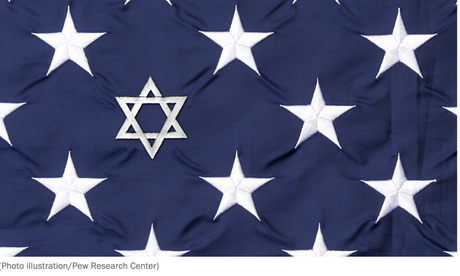
Trying to survey the Jewish community is an important, and thankless, task.
Today, Pew Research released their first national study of the Jewish American landscape since 2013. Every assumption, every question, every result, will be scrutinized and debated for years to come.
For interfaith families, there is not really a whole lot that is new to report. In fact, more intriguing and detailed data and analysis has been released elsewhere recently. But I'll get to that in a moment.
From the point of view of interfaith families, it is important to remember that virtually all studies of interfaith families and the Jewish community, including this Pew report, are funded by Jewish foundations or institutions. So the framework is built on the concerns and questions of institutional Judaism in America. As a result, there are a lot of questions that will feel archaic or beside-the-point to a lot of young American Jews, and to a lot of interfaith families. There's a lot about relationships to Israel. There's a lot about participating in traditional Jewish ritual and membership. There are gendered analyses about the role of the mother and the father.
Some two dozen rabbis are thanked in the Pew report acknowledgements, including those notorious for opposing interfaith marriage. It all feels fraught, and weighed down, with traditional Jewish continuity narratives, given how mixed a multitude we are now.
What does this mean for interfaith families? Many of us were excluded from the study. Pew classified people as Jewish, Jewish background, or Jewish affinity, with the bulk of the study focused only on those deemed "Jewish." Pew created a complex set of rules based on parentage, upbringing, and current identity, for deciding which category to put each person.
- Regardless of their Jewish parentage or Jewish upbringing, anyone who claimed to be both Jewish and Buddhist, or Jewish and Unitarian-Universalist, or Jewish and Pagan, or Jewish and any other religion, was excluded from counting as Jewish, and from the body of this study.
- Someone who claims Jewish cultural identity but no religious identity, and has only one Jewish grandparent, was counted as Jewish if they were raised Jewish.
- Someone who claims Jewish cultural identity but no religious identity, and has only one Jewish grandparent, but was not raised Jewish, was counted only as having Jewish affinity.
Pew did include in their overall Jewish population what they estimate are 200,000 children being raised in Judaism and another religion. However, they excluded an estimated 200,000 adults who identify as Jewish and another religion. Pew's explanation: "This accounts for the uncertainty inherent in projecting how children will identify when they grow up; some children who are raised as Jewish and another religion go on to identify, in adulthood, solely as Jewish."
Pew cautions us not to compare this year's study directly with their last study of Jews in America in 2013. In part this is because they have shifted their sampling from phone calls, to written and online responses. It is not immediately clear to me why the percentage of interfaith couples raising children with more than one religion would have gone down from 25% in 2013 to 12% in 2020. I suspect this has something to do with the increasing number of multi-generational interfaith families being excluded from the "Jewish" category.
What I do know is that the 12% figure does not align with my experience as someone who works full-time supporting interfaith families, nor does it align with recent individual community studies. Anecdotally, one group of Reform rabbis told me that about 50% of the interfaith couples they are now marrying want to "do both." And recently, I was contacted by two Reform rabbis to speak to a group of interfaith couples, after the rabbis discovered that all of the couples in their group were intending to "do both."
Even though they are funded by Jewish communities, some recent studies of specific regions align more closely than today's Pew study with my experience of the growing awareness that you can, indeed, give interfaith children an interfaith education.
In Toronto, 44% of interfaith couples with one Jewish parent are raising kids "with two religious heritages" (as opposed to 39% raising kids exclusively Jewish), according to a 2020 report. This detailed report on interfaith families in Toronto appears to have drawn heavily on my work, revealing texture and nuance, and I will return to it in another post.
Another survey done last year in the Pioneer Valley of western Massachusetts (including Amherst and Northampton), found 46% of interfaith couples with one Jewish parent are raising kids "Jewish and another religion," (as opposed to 33% raising them exclusively Jewish by religion). And in Minnesota's Twin Cities (Minneapolis and St Paul), a 2019 study found 34% of interfaith couples with one Jewish parent raising children with two religions, while 16% were raising them exclusively Jewish by religion. Not surprisingly, studies (many older) of the big cities in the East with many deep-rooted Jewish institutions found smaller percentages (many of them 11-18%) of interfaith families "doing both."
Later this week, the new Pew report will be analyzed by Jewish interfaith family professionals in an online briefing. I intend to listen to that session, and hope to report back here on anything new or noteworthy. Stay tuned.
Journalist Susan Katz Miller is an interfaith families speaker, consultant, and coach, and author of Being Both: Embracing Two Religions in One Interfaith Family (2015), and The Interfaith Family Journal (2019). Follow her on twitter @susankatzmiller.

